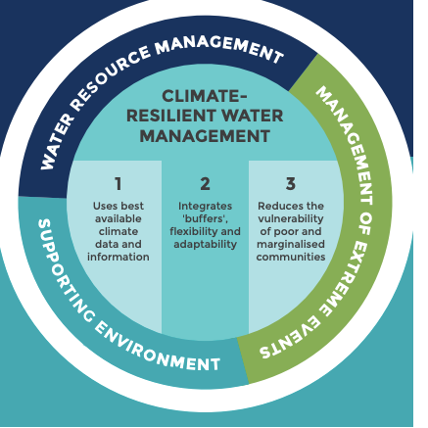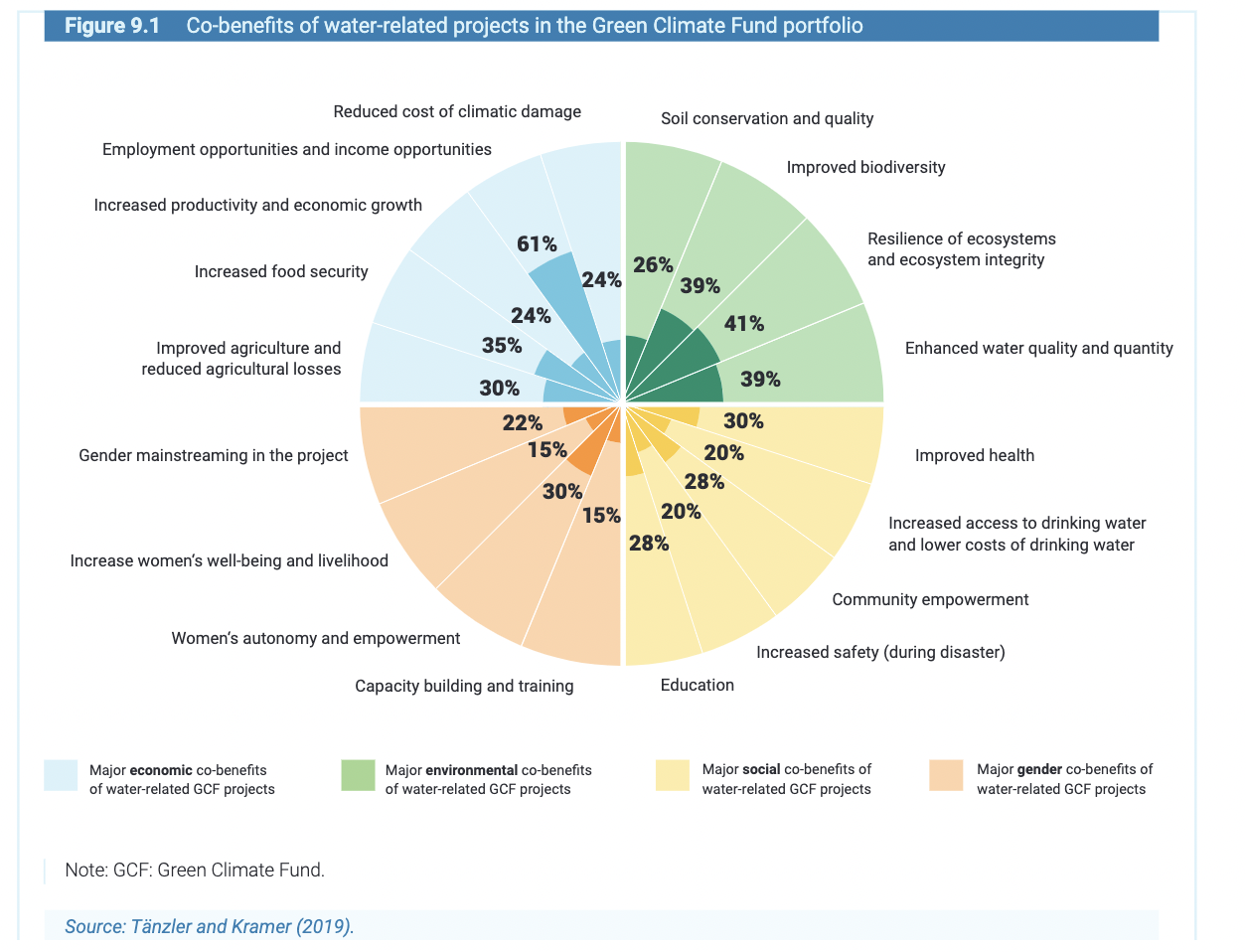المُلخص التنفيذي
As we learned in factsheet 1.1, climate and water challenges are inextricably linked. Even though the main pressure on freshwater resources is human activity, climate change has an impact on the water cycle, leading to devastating water-related events such as droughts and floods. In this factsheet, we will present you with an overview of the main challenges we are currently facing regarding climate change using a water management lens. We will explain why it is essential to consider these two sectors while developing policies, adaptation and management plans.
Self Assessment
- What does climate resilient water management mean to you?
- Which elements are essential to ensure good governance in the water and climate sector?
As we learned in factsheet 1.1, the water and climate sectors are interdependent. This explains why “addressing climate change through water management should build on a coordinated response that strikes a balance between different sectoral objectives and needs of all water users, including the environment.” (WWDR, 2020)
Water management strategies can also have a negative impact on the fight against climate change if both sectors are not considered. For example, greenhouse gas emissions can be generated when a water purification method is powered by a non-renewable energy source. (WWDR, 2020)
Furthermore, modifications in the water cycle caused by climate change make it more challenging to sustainably manage water resources and reach SDG 6, ensuring availability and sustainable management of water and sanitation for all by 2030 (UN, n.d.). The following sections will give you an overview of essential elements which must be taken into account if we want to make sure that we implement efficient and integrated climate and water management strategies.
Climate resilient water management
To tackle the water and climate crisis, the water sector must adapt to the impacts of climate change on water resources. Such impacts include extreme weather events and increased water scarcity. Climate resilient water management is needed to mitigate the effects of climate change on the water sector (WWDR, 2020). Furthermore, climate resilient water management can act as a mechanism in climate change mitigation and adaptation strategies (UN, 2019).
Climate resilient water management is essential to tackle the current climate crisis. Sustainable water management is at the core of several climate change adaptation strategies addressing droughts, agriculture, flooding, water availability, etc. However, it should also be considered when thinking of climate change mitigation strategies.
The climate resilient water management approach is based on 3 principles:
- The use of the best available data and information for the decision making,
- the integration of buffers, flexibility, and adaptation in the solution,
- the increase of the resilience of vulnerable communities by reducing their vulnerability to the impacts of climate change. (Action on Climate Today, 2018)
Although the water sector must adapt to the impacts that climate change is having on the water cycle (such as extreme weather events) and to increase global water demand, it can also play a major role in climate change mitigation. For instance, the use of different natural methods such as wetland protection, mangrove protection and agricultural conservation act as natural carbon sinks. Also, the implementation of more efficient wastewater management systems can reduce the energy demand which can contribute to the reduction of greenhouse emissions. (WWDR, 2020)

1.1. Image source: adapted from http://www.acclimatise.uk.com/wp-content/uploads/2018/02/ACT-Water-Brief_1.5-Spread.pdf
Transboundary cooperation
60% of freshwater flows around the world are shared by more than one country. Transboundary cooperation is thus essential if we wish to collectively address the impacts of climate change and to avoid maladaptive consequences. (IUCNE, s.d.; UNECE/INBO, 2015). Cooperative water management strategies also reduce the risk of conflict within regions which are either sharing or having an impact on the same water source. (IUCNE, s.d.)
The United Nations Economic Commission for Europe (UNECE) has recognized this challenge and as a result published a report on water and adaptation to climate change in 2009 and on Disaster Risk Reduction, water and adaptation in 2018 (UNECE/UNDRR).
Despite these efforts, there is still a significant lack of funding for transboundary cooperation projects and even when funding is available, it is not always straight-forward to finance a transboundary project since these tend to be highly politicised. Due to the important place occupied by climate change on the political agenda, in some cases, highlighting the links between transboundary cooperation and climate change can help leverage additional political support for financing of such projects. Numerous countries across Europe and worldwide have been incorporating transboundary water management in their adaptation strategies and plans. For instance, this was done across the ECE region in Europe. (WWDR, 2020) These experiences have shown that good communication, monitoring and data sharing, sectoral cooperation, capacity building support and sustainable funding mechanisms are key elements for success (UNECE/INBO, 2015).
Water Governance
The scarcity of water resources often means that several sectors compete for their use. This is where water governance comes into play. Fair and inclusive water management is necessary to promote an efficient and equitable use of the resource, which is sometimes not sufficient to meet demand (WWDR, 2020).
The interests of the different sectors requiring the use of a water resource are often not aligned which makes integrated, and inclusive water governance essential (WWDR, 2020). The increasing competition between sectors for water resources reinforces the need for more central and influential governance bodies to co-create climate policies.
It is also essential that non-state actors, such as NGOs and the private sector, participate in the policy making process since in most countries government alone cannot provide water services to all (Jimérez and Pérez-Foguet, 2010; WWDR, 2020). Integrated water resources management provides a framework that allows the involvement of stakeholders related to the 3 axes of sustainable development: the society, the economy, and the environment (UN Environment-DHI, 2018).
“Mitigation comprises human interventions to reduce the sources or enhance the sinks of greenhouse gases (GHGs). While mitigation options are also available across every major water-related sector, they remain largely unrecognized” (WWDR, 2020).
What is good governance?
“Good governance involves adhering to principles of human rights, including effectiveness, responsiveness and accountability; openness and transparency; participation in the performance of key governance functions relating to policy and institutional arrangements; planning and coordination; and regulation and licensing” (UNECE, 1998; OECD, 2015).
Financing
Initiatives which aim to achieve water security and sustainable water and sanitation management (SDG 6) are underfunded (WWDR, 2020). For instance, 114 billion USD are needed every year to reach 2 out of 6 goals related to SDG 6, representing 3 times the current investment in the water, sanitation, and hygiene (WASH) sector (Hutton & Varughese, 2016). If we don’t significantly increase the investment in the water sector, there is little to no chance we will achieve SDG6 by 2030 (Fonseca & Pories, 2017).
However, as we mentioned in factsheet 1.1, the impacts of climate change on the water cycle create pressure on water resources management, an increase of extreme weather events and additional pressure on water and sanitation services. The link between water and climate change can be a great opportunity to seek more funding for water resources management by leveraging finance dedicated to climate change adaptation and mitigation (WWDR, 2020). In 2016, 455 billion USD were invested in the fight against climate change. However, even though water management is at the heart of climate change adaptation and mitigation strategies, only 0,7 billion US were invested in water management. This represents only 2,6% of the total funds dedicated to the fight against climate change (CPI, 2018).
As of 2020, there are three international financing mechanisms dedicated specifically to projects related to climate and the environment, including water: The Green Climate Fund, The Global Environment Facility and The Adaptation Fund. In 2016, they jointly provided 51 billion US, or 11% of all climate financing (CPI, 2018). Other national and regional financing mechanisms are in place in many countries both in the private and the public sector. To learn more about the other financing mechanisms please refer to: WWDR, 2020 in the resources section.
One of the main challenges for the water sector in accessing these funds is demonstrating the link between water management and climate change mitigation or adaptation. Up until now, it has been easier to link water management strategies to climate change adaptation initiatives as opposed to mitigation projects. It has been demonstrated that SDG 6 is interlinked to all other SDG goals and is often a catalyser towards achieving global sustainability. Other SDG goals play the same role in the success of SDG 6, such as SDG 13, dedicated to climate action. Mitigation and adaptation strategies can directly impact the demand, quality and availability of water resources. To see an example of the broad benefits of funding water-related projects in the climate sector please refer to graphic 1.2. (WWDR, 2020)

1.2. Image source: WWDR, 2020
“Adaptation encompasses a combination of natural, engineered and technological options, as well as social and institutional measures to moderate harm or exploit beneficial opportunities from climate change. Adaptation options exist in all water-related sectors and should be investigated and applied where possible.” (WWDR, 2020)
Climate-Resilient Water Management – An operational framework from South Asia. United Kingdom: Action on Climate Today
Climate Resilient Water Management – Water Brief. United Kingdom: Action on Climate Today
Financing WASH: how to increase funds for the sector while reducing inequities
This Position Paper addresses three key issues that are receiving limited attention in the water and sanitation sector discussions on (blended) finance:
- The lack of finance for strengthening the enabling environment
- The untapped use of micro and blended finance
- The inequities in allocation of finance in the sector
